Physical Address
304 North Cardinal St.
Dorchester Center, MA 02124
Osteomyelitis is defined literally as inflammation of bone and marrow, albeit, the common use of the term virtually always implies infection. Infection of the skeleton, the largest organ system of the body, is important because it is a major site of microbial infestation that is often morbid and sometimes fatal. All types of organisms, including bacteria, mycobacteria, fungi, viruses, and parasites, can cause osteomyelitis, but infections associated with certain pyogenic bacteria and mycobacteria are the most common. The microbes and their interplay with the host produce a wide spectrum of clinical manifestations that are further influenced by the causative event, bone involved, specific pathogen and its virulence, medical condition of the host, type of therapy, and clinical course of the disease. Many of the molecular mechanisms underlying these biologic interactions have been elucidated, and this knowledge has facilitated advances in the stalwarts of therapy, namely, surgery and antibiotics. Regardless, the complexities and problems in diagnosing and treating osteomyelitis have become ever more challenging because of the increase in the numbers of older adults and joint replacements, widespread prevalence of diabetes, high frequency of antibiotic-resistant pathogens, and expanding population of immunocompromised patients and their exotic opportunistic infections.
The fundamental biologic processes active in bone infection are independent of pathogen type. Entry of the organism into bone is the first step in osteomyelitis and occurs by three main mechanisms: (1) hematogenous seeding, (2) extension from a contiguous site, and (3) direct implantation ( Box 14.1 ).
Hematogenous spread
Contiguous extension
Direct implantation
Hematogenous osteomyelitis is usually caused by bacteria and most commonly affects rapidly growing long bones. In children, it likely results from occult bacteremia associated with seeding of a site susceptible to bacterial invasion. It frequently presents as a primary solitary focus of disease but, importantly, may be a complication of any localized or systemic infection. Within a long bone, the anatomic site infected depends on whether the patient is an infant, child, or adult, and the relationship between age and localization is based on the vascular anatomy of the bone. Briefly, the nutrient artery supplies the majority of blood flow to bone, and during growth and development after the first year of life, its terminal branches end as capillaries at the base of the growth plate ( Fig. 14.1A and B ). As the capillaries approach the epiphyseal plate, they reverse direction by forming a loop and then merge into a network of sinusoidal venous blood lakes, which in turn empty into the venous drainage system of the medullary cavity. The blood flow in the capillary-sinusoid loop region is sluggish and turbulent, and phagocyte function is suboptimal; together, these features facilitate deposition of the organism into the metaphyseal tissue. In infants younger than 1 year, some of the terminal branches of the nutrient artery penetrate the growth plate, and as they end near the base of the articular cartilage their diameter expands, forming large venous lakes resembling metaphyseal sinusoids. Thus in neonates, microbes may settle in the epiphysis or quickly spread into this region from a metaphyseal focus of disease. In neonates and children, transphyseal blood vessels facilitate direct extension into the adjacent joint because the metaphysis is intra-articular in this age group. In adults, after closure of the growth plate, the metaphyseal and epiphyseal vessels establish reconnections so bacteria entering the nutrient artery are directed to the vascular loops beneath the articular cartilage. Accordingly, acute hematogenous osteomyelitis in infants and adults often affects the epiphysis, whereas in children the growth plate acts as an effective barrier and the infection is usually limited to the metaphysis.
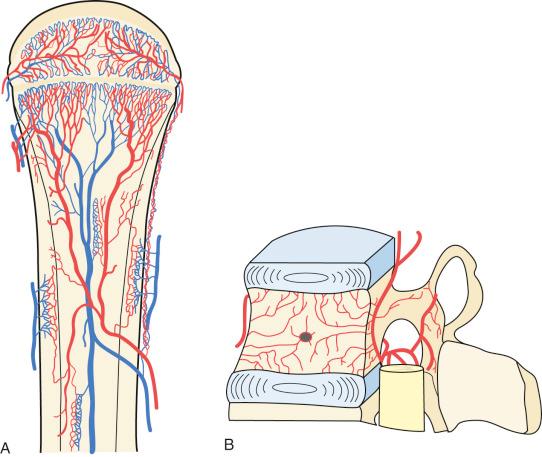
After microbes seed the tissue, they adhere to the organic matrix or invade into cells, where they reproduce, forming growing colonies. The enlarging morass of organisms can obstruct blood flow, causing thrombosis and infarction, which creates an environment conducive to further propagation. Structural elements of the microbes or their secreted by-products that are detected by the host trigger the innate and adaptive immune responses, which may vary according to the type of microbe. After being initiated, the immunologic reaction causes the contaminated area to become inundated with fluid, fibrin, degranulated platelets, extravasated red blood cells, and inflammatory cells ( Fig. 14.2 ). This phlegmon and developing abscess increases intraosseous pressure, which forces the inflammatory reaction through the medullary cavity and into haversian systems and Volkmann canals, causing necrosis of sometimes a sizable segment of bone—the devitalized bone is known as a sequestrum ( Fig. 14.3 ). In infants and young children, the periosteum is not tightly bound to the cortex, so it may be mechanically lifted off the bone surface over large distances, disrupting periosteal feeding vessels and significantly enlarging the region of bone necrosis. The pus also may perforate the periosteum and extend into neighboring soft tissues, forming an abscess that can burrow to the skin surface, creating one or more sinus tracts that drain discolored exudates and necrotic tissue. Lastly, the pus may extend into the epiphysis, where it can penetrate the articular surface or spread along capsular and tendoligamentous insertions into the joint. Consequently, septic or suppurative arthritis develops that can be associated with severe destruction of the articular cartilage and eventual permanent disability. This complication most frequently affects articulations whose joint capsules insert into cortices beyond the confines of the epiphysis.
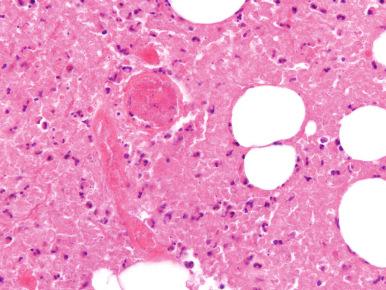
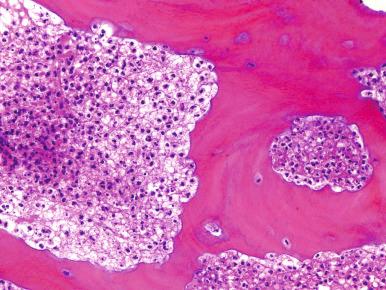
As the acute phase intensifies over a period of several days to weeks, the inflammatory cells and their released enzymes and cytokines ( Box 14.2 ) form a biologic broth that has powerful effects on the resident cells and biomaterials that compose the bone tissue. Accordingly, osteoclasts are generated, and in this setting their numbers and activity are more extreme than in any other disease process. The osteoclasts target and resorb necrotic bone, thereby creating space for the expanding inflamed granulation tissue ( Fig. 14.4 ). The evolving response leads to the arrival of lymphocytes, plasma cells, macrophages, collagen-producing fibroblasts, and newly formed blood vessels, which herald the so-called chronic phase of osteomyelitis. Mesenchymal stem cells located in the medullary cavity, cortex, and periosteum are stimulated simultaneously to produce osteoblasts that manufacture and secrete newly formed viable bone, usually woven in architecture. The living bone forms a subperiosteal shell, known as the involucrum that envelops the necrotic cortical sequestrum, as well as a zone of sclerosis around the intramedullary extent of infection ( Fig. 14.5 ). Over time, bone remodeling continues and the nidus of infection may become walled off by the host reaction, forming an intraosseous abscess, also known as a Brodie abscess ( Fig. 14.6 ). Some infections, especially those in the jaw bones, are associated with extensive new bone formation that obscures much of the underlying osseous structure, and this form of disease is known as sclerosing osteomyelitis of Garré.
RANKL
RANK
OPG
Macrophage colony-stimulating factor
Tumor necrosis factor
Interleukin-1
Interleukin-6
Interleukin-7
Interleukin-8
Interleukin-10
Interleukin-12
Interleukin-15
Interleukin-17
Interleukin-18
Interleukin-23
Interferon
OPG , Osteoprotegerin; RANK , receptor activator of nuclear factor-ĸB; RANKL , receptor activator of nuclear factor-ĸB ligand.
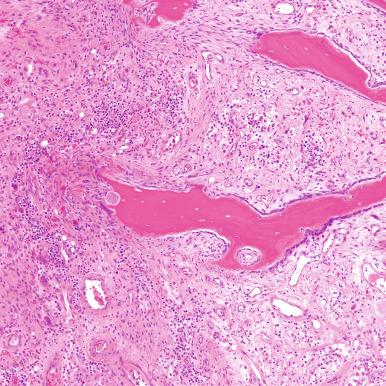
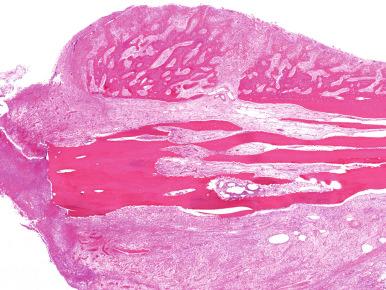
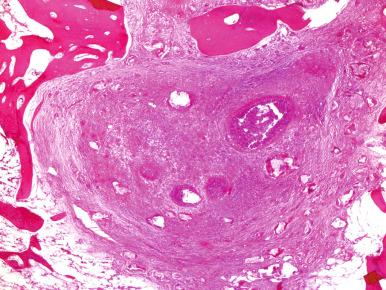
Hematogenous osteomyelitis also affects other portions of the skeleton. More common locations include metaphyseal equivalent sites in long bones (adjacent to the femoral trochanters and tibial tuberosity) and flat and irregular bones (ilium adjacent to the triradiate cartilage, ilium adjacent to the acetabular roof, ilium adjacent to the anterior inferior spine, ilium adjacent to the sacroiliac joint, and ilium adjacent to the crest, etc.). The organisms preferentially seed these regions leading to an inflammatory reaction and bone destruction.
In the spine, blood-borne pathogens usually localize to the subchondral regions of the vertebral body. These areas have the richest vascular supply and are fed by branches of the spinal artery and drained by a venous plexus. The proliferating organisms and inflammatory reaction digest and transgress the hyaline cartilage end plate and extend into and destroy the intervertebral disk. Spread to adjacent vertebral bodies is common. If the inflammatory process violates the periosteum, inflammation can accumulate in the surrounding soft tissue, such as the epidural space or along or in the iliopsoas and paravertebral muscles.
Osteomyelitis resulting from contiguous spread occurs after organisms from a neighboring anatomic site gain direct access to the bone. This may affect any bone adjacent to a soft tissue abscess and is more commonly seen in the setting of periodontal and sinus disease, cellulitis of diabetic feet, epidural abscess, decubitus ulcer, or septic arthritis. In these situations the inflammatory process must first destroy the periosteum or articular surface before it accesses the bone. Unlike hematogenous osteomyelitis, the cortex instead of the medullary cavity is initially infected, and the site at which this occurs influences the rapidity of spread and extent of disease.
Direct implantation of pathogens into bone takes place in a variety of circumstances. Common scenarios are contamination of an open fracture, penetration of fomites, such as shrapnel or orthopedic hardware into bone, or bone that is exposed during surgery. In these situations the causative event and the extent of associated hemorrhage, tissue fragmentation, and necrosis influence important aspects of the infection.
The balance between the biologic characteristics of the pathogen and host determines the extent of the osseous manifestations of the infection and the ability of the host to confine and eradicate the organism. All too frequently, the pathogens remain viable and continue to proliferate in an environment of necrotic tissue inaccessible to the immune response and therapeutic antibiotics. In this fashion a smoldering chronic infection is generated, which maintains the potential to cause future havoc when conditions are permitting.
Bacterial infection of the skeleton accounts for the vast majority of microbial diseases of bone. It causes a variety of different clinicopathologic conditions that are related to the mode of infection, anatomic site, type of organism, and condition of the host. Approximately 20% of cases of bacterial osteomyelitis are hematogenous in origin, with the remainder secondary to contiguous spread and direct inoculation.
Bacterial hematogenous osteomyelitis is typically acute and most often develops in children. Indeed, in 50% of cases the patients are younger than 5 years, and in more than 85% of cases the patients are 16 years or younger. The annual incidence has remained relatively constant over the past several decades and is estimated to affect 1 in 5000 to 10,000 children annually. Males are affected almost twice as frequently as females. Predisposing factors include indwelling catheters; infections of the skin, throat, ears, lung, heart, and genitourinary tract; nonpenetrating trauma; and such underlying diseases or conditions as diabetes, renal failure, hemoglobinopathies, and immunosuppression. More often than not the host is healthy and the source of the bacteria is obscure with the initiating bacteremia possibly complicating trivial occurrences, such as occult injury to the intestinal mucosa during defecation, vigorous chewing of hard foods, or minor infections of the skin.
The bones most commonly affected in children are the long tubular bones of the extremities, especially the femur (36%), tibia (33%), and humerus (10%). In most instances the infection involves a single osseous site, but in 5% to 20% of cases it is multifocal in distribution. In adults the spine is most commonly involved, accounting for 2% to 4% of all bone infections. Most cases originate in the lumbar vertebrae (58%), followed by the thoracic (30%) and cervical vertebrae (11%). The spine is also the most frequent site of infection in intravenous drug abusers. In patients with sickle cell disease, the osteomyelitis usually occurs in the long bones, followed by the vertebrae.
Clinically, hematogenous osteomyelitis may manifest as an acute systemic illness with malaise, fever, chills, leukocytosis, elevated sedimentation rate and C-reactive protein level, and edema, swelling, warmth and marked-to-intense throbbing pain over the affected region. The presentation may be more subtle with only unexplained fever, particularly in infants, or only localized pain in the absence of fever in the adult.
Imaging studies reveal changes that vary with the stage of infection. Technetium bone scan becomes positive within 24 to 48 hours after the development of symptoms. X-rays may reveal deep soft tissue swelling after several days; however, it takes 10 to 21 days for changes to manifest in bone because 30% to 50% of the osseous tissue must be resorbed before the infection becomes apparent on plain films. The focus of infection first presents as a poorly defined area of radiolucency in the metaphysis that increases in breadth over time and in children may extend to the growth plate by an irregular channel ( Figs. 14.7A, 14.8A, and 14.9A ). Subsequently, reactive new bone is deposited both beneath the raised periosteum and within the medullary canal at the boundary of disease. Extraosseous spread may be associated with a cortical cloaca and a contiguous abscess ( Fig. 14.10 ). Computed tomography (CT) scans more precisely delineate the presence of gas, extent of bone destruction, the formation of sequestra and involucra, and soft tissue involvement (see Figs. 14.9B and 14.10B ). Magnetic resonance imaging (MRI) detects edema and the inflammatory changes 3 to 5 days after the beginning of infection. It does not demonstrate the bony changes as well as CT but is better in revealing the extent of disease, the presence of intraosseous and soft tissue abscesses, zone of surrounding edema, and joint effusions and joint involvement (see Figs. 14.7B, 14.8B, and 14.10C ). If confined over time an intraosseous abscess (Brodie abscess) may develop and can mimic a neoplasm ( Fig. 14.11 ).
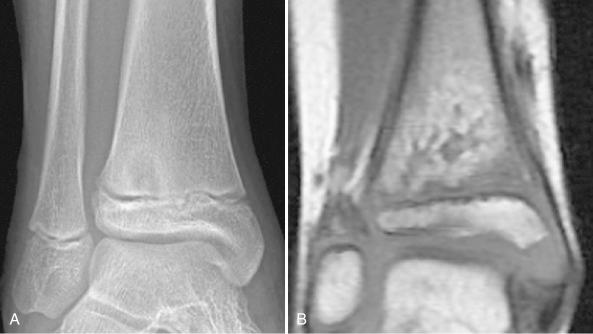
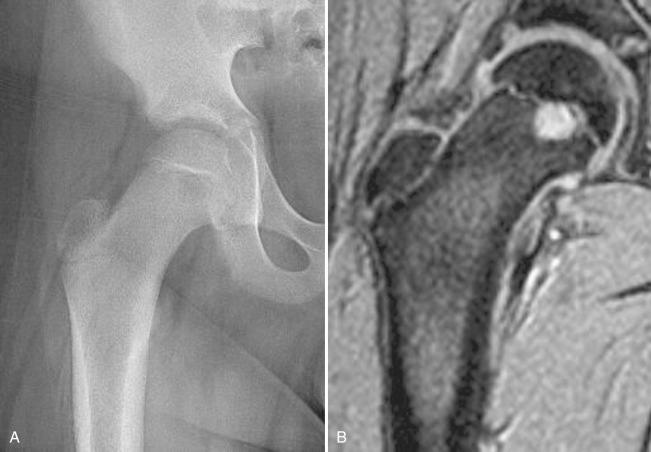
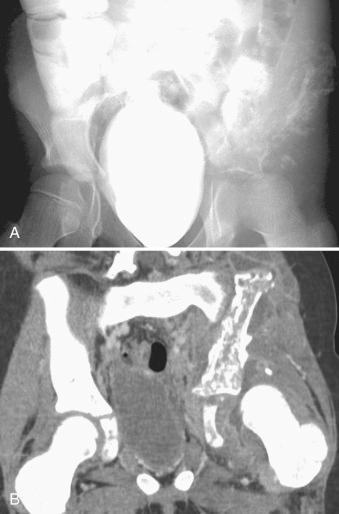
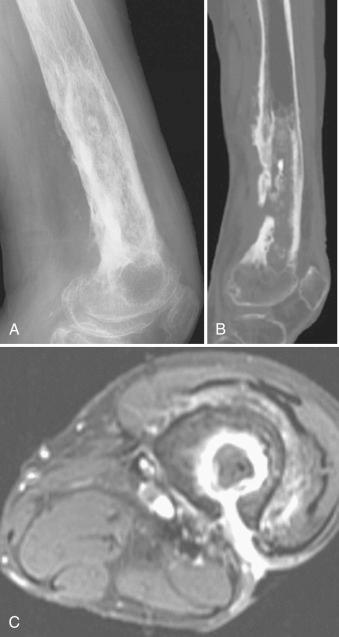
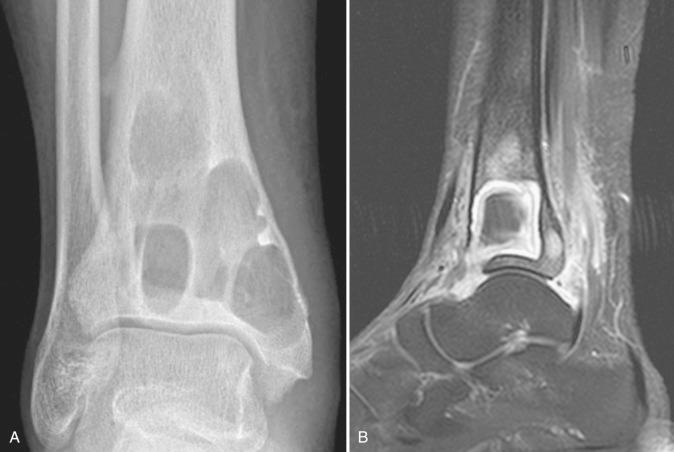
Vertebral infection usually localizes to the anterior subchondral portion of the vertebral body in close proximity to the intervertebral disc. Within several weeks the disc becomes involved and is associated with loss of height and blurring of the normal contour of the subchondral bone plate. Progressive destruction of the bone and disk ensues, and the neighboring vertebrae and soft tissue may become involved ( Figs. 14.12 to 14.14 ).
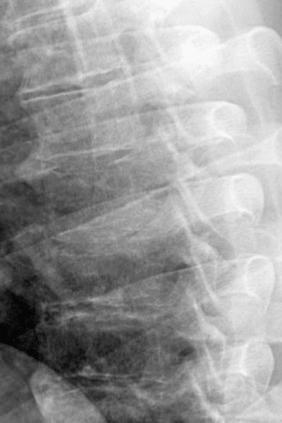
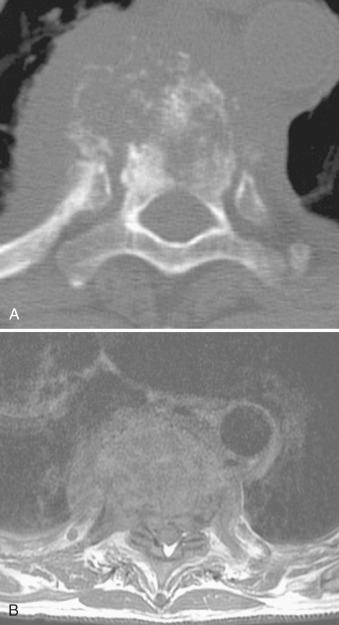
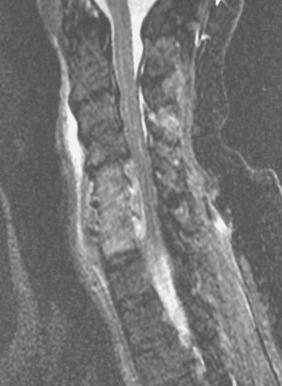
Pathologically, bacterial infection usually elicits a suppurative inflammatory response with edema, fibrin, hemorrhage, and necrosis. Necrosis of bone manifests as osseous tissue with empty lacunae, and in the setting of infection many of its surfaces are either covered by osteoclasts or are pockmarked by Howship lacunae ( Fig. 14.15 ). Colonies of bacteria may be found in the inflammatory infiltrate and necrotic tissue ( Fig. 14.16 ). After several weeks the marrow becomes replaced by reactive fibrovascular tissue and the inflammatory infiltrate becomes enriched with lymphocytes, plasma cells, and macrophages ( Fig. 14.17 ). In some cases the plasma cells are so numerous (plasma cell osteomyelitis) they can cause confusion with plasma cell neoplasms ( Fig. 14.18 ). Intraosseous abscesses consist of granulation tissue admixed with inflammatory cells. The reactive bone that forms is frequently woven and is deposited beneath the periosteum and within the medullary cavity de novo or on the surfaces of preexisting living or necrotic trabecular bone (see Fig. 14.5 ).
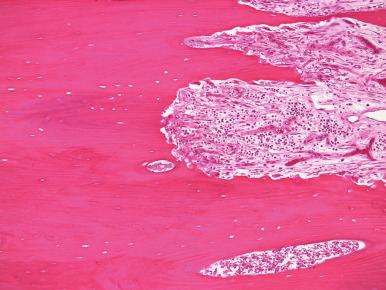
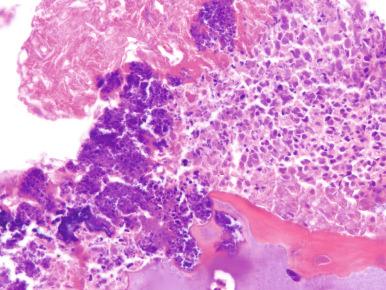
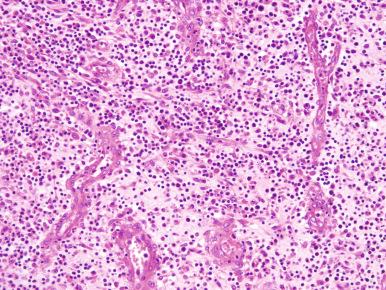
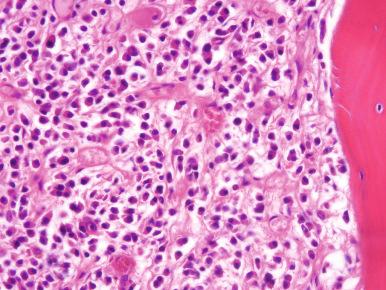
Importantly, some bacteria are associated with granulomatous inflammation, including multinucleated Langhans-type giant cells. This type of inflammatory response can be associated with infections by Salmonella , Brucella , Bartonella , Coxiella burnetii (Q fever), and Burkholderia pseudomallei (melioidosis).
Most specimens from bacterial hematogenous osteomyelitis are derived from curettage specimens, so the gross findings may be difficult to appreciate but may contain green-tan discolored pus that can be putrid. Resection specimens are typically derived from patients with longstanding chronic disease. In these instances the necrotic tissue is discolored green-tan-brown, and the fibrotic marrow is white gray. The cancellous bone in the center of the infection is largely destroyed by the fibrous tissue, and the surrounding bone is sclerotic, having been rebuttressed. The cortex is frequently thickened in an irregular fashion by subperiosteal reactive bone, and a cloaca appears as a round or oval hole in the cortex that is in continuity with soft tissue involvement ( Fig. 14.19 ).
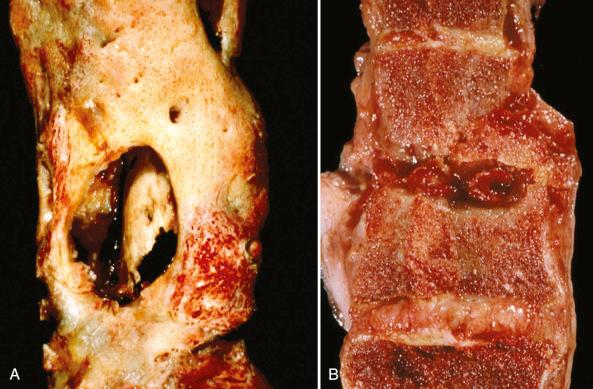
Staphylococcus aureus is responsible for 80% to 90% of the cases of bacterial hematogenous osteomyelitis in which an organism is recovered. Aspects of the infection may be related to virulence factors elaborated by different clonal types. Group A and B streptococci and gram-negative organisms are important etiologic agents in neonates. Haemophilus influenzae has become less important following the introduction of the vaccine to this organism. Salmonella complicates sickle cell disease, and Escherichia coli , Pseudomonas , and Klebsiella are more frequently isolated from patients with genitourinary tract infections or who are intravenous drug abusers.
The diagnosis can be strongly suggested by the characteristic clinical and imaging studies. However, in some cases, especially in children, the destructive process may mimic a primary malignancy, such as Ewing sarcoma or osteosarcoma. In many untreated cases, blood cultures are positive, but biopsy and bone cultures are required to identify the pathogen in most instances. The combination of antibiotics and surgical drainage is usually curative; however, in 5% to 25% of cases, acute osteomyelitis fails to resolve and persists as chronic infection. Chronicity may develop when there is delay in diagnosis, extensive bone necrosis, abbreviated antibiotic therapy, inadequate surgical débridement, and weakened host defenses. Acute flare-ups may mark the clinical course of chronic infection and are usually spontaneous, have no obvious cause, and may occur after years of dormancy. Other complications of chronic osteomyelitis include pathologic fracture, secondary amyloidosis, endocarditis, sepsis, development of squamous cell carcinoma in the sinus tract, and rarely sarcoma in the infected bone.
Bacterial infection can spread from a poorly controlled neighboring juxtaosseous infection to involve bone. In this situation the proliferating bacteria devitalize the periosteum or digest the articular cartilage so that they gain entry to the cortex or medullary cavity. Patients with common conditions (such as periodontal disease, caries, sinusitis, cellulitis of the feet and toes), patients with severe peripheral vascular disease (especially diabetics), and individuals who are immobile and suffer from decubitus ulcers are prone to this type of infection.
Osteomyelitis of the jaws frequently follows periodontal disease and caries ( Fig. 14.20 ). Many patients also have a history of previous radiation, which compromises the gingiva and induces necrosis of the underlying bone. The exposed bone acts as a good medium for bacterial pathogens and frequently becomes infected by multiple organisms, including S. aureus , Streptococcus spp., and Actinomyces .
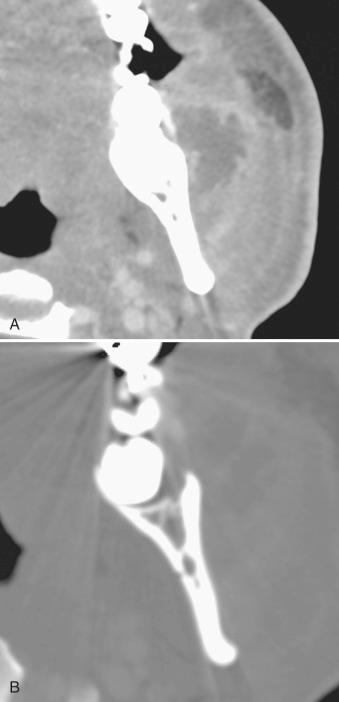
Actinomycosis most commonly occurs in the jaws and is often associated with chronic infection, including draining sinuses. It is often seen in the setting of osteoradionecrosis and in patients who have been treated with bisphosphonates.
Bisphosphonate-induced osteonecrosis has recently been the focus of attention because of the widespread use of bisphosphonates and the controversy regarding the pathophysiology of its genesis. The first large series of bisphosphonate-induced osteonecrosis was described in 2003 and occurred in patients who had a malignancy, frequently myeloma, and who were receiving intravenous bisphosphonates. Patients typically have a history of a recent dental procedure and present with exposed bone that is necrotic but also infected with actinomyces ( Fig. 14.21 ). It is unclear whether the infection is the primary causative event or is secondary and whether it begins in the gingiva or in the bone. Pathologic examination of surgical specimens shows gingival inflammation and ulceration and necrotic bone infiltrated by actinomyces and neutrophils ( Fig. 14.22 ). The organisms are pleomorphic, branching, filamentous gram-positive bacteria that frequently aggregate into sulfur granules and exhibit the Splendore-Hoeppli phenomenon. The disease can be chronic and recurrent, and treatment commonly includes surgical débridement and antibiotics.
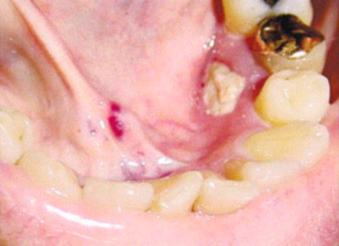
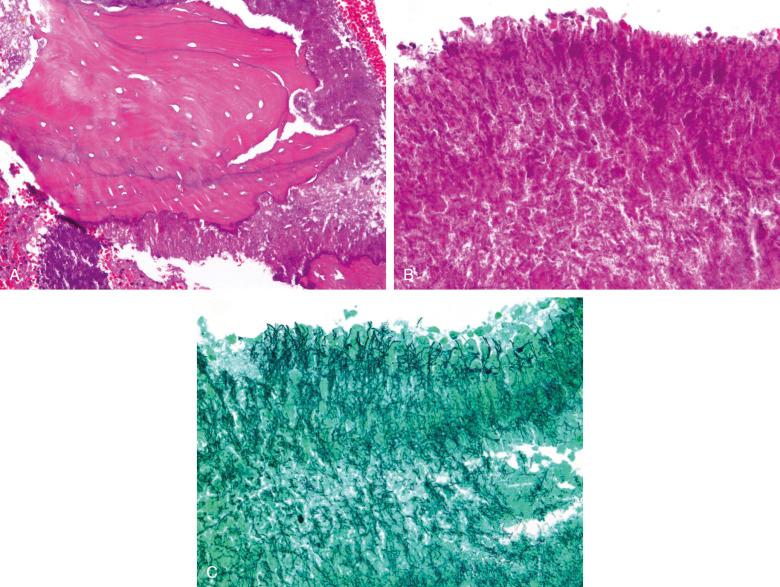
The development of osteomyelitis as a complication of bacterial sinusitis is uncommon. Patients range from adolescents to older adults and present with headache, swelling, fever, and discharge. The most common site of involvement is the frontal sinus. In this region, osteomyelitis may produce a subperiosteal abscess that may present as a soft tissue mass of the forehead known as Pott puffy tumor. The more common pathogens include S. aureus , nonenterococcal streptococcus, and oral anaerobes.
Osteomyelitis of the feet in patients with vascular insufficiency, particularly diabetics, is a serious problem. The ulcers develop because of the combination of neuropathic, ischemic, and local biomechanical changes that subject the skin and soft tissues to excessive pressure, friction, breakdown, and necrosis while eliciting sometimes only minimal local symptoms ( Fig. 14.23 ). The development of osteomyelitis in these patients is usually a complication of a nonhealing ulcer that gradually involves the deeper soft tissues until the periosteum is breached. After the bone is exposed, the cortex may undergo necrosis with the infection spreading along its length and into the medullary cavity via the haversian systems. Joint involvement is relatively common in severe disease ( Fig. 14.24 ). As the bone is resorbed, it may undergo secondary fracture with callus formation. Bone cultures frequently identify S. aureus , which may be methicillin resistant, followed by Staphylococcus epidermidis. E. coli , Klebsiella pneumoniae , and Proteus spp. are followed by Pseudomonas aeruginosa as the most common pathogens among Enterobacteriaceae.
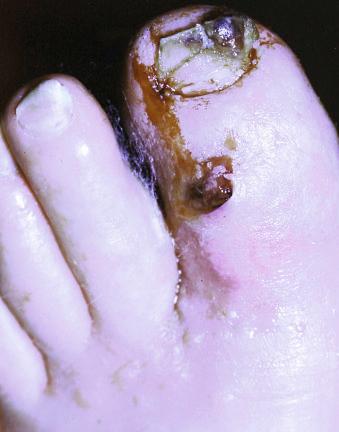
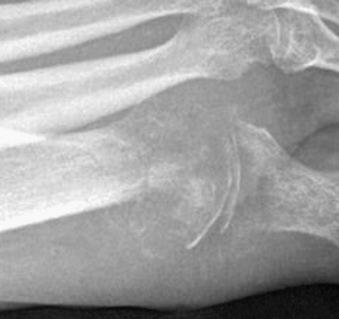
Infection of bone beneath a decubitus ulcer typically develops when a pressure sore fails to resolve and the bacteria and inflammation extend into the underlying osseous tissue. This complication develops in 17% to 32% of infected decubiti. The patients usually lack sensation in the affected region and are immobile and poorly nourished. Common sites for this problem are the sacrum, posterior calcaneous, ischial tuberosities, greater trochanters, elbows, scapulae, and lateral malleoli. The infection is polymicrobial and includes aerobes ( Proteus mirabilis , E. coli , Enterococci , staphylococci, and Pseudomonas spp.) and anaerobes ( Peptostreptococcus spp., Bacteroides fragilis , and Clostridium perfringens ). The infection may involve only the superficial portion of the bone or be more extensive. The histologic findings frequently show the features of chronic osteomyelitis.
Bone infection caused by direct implantation of bacteria into bone has diverse etiologies. The common thread to all is that the bone is either exposed or violated, giving bacteria direct access to osseous tissue. Degloving injuries or open fractures in which the fractured ends of the bone pierce the skin and become contaminated are serious injuries. The extent of the trauma, amount of tissue necrosis, degree of contamination, amount of available soft tissue coverage, rapidity and skill of surgical intervention, and state of the host influence wound healing. Unfortunately, 3% to 50% of open fractures eventually become infected, with bacteria residing in pieces of necrotic bone. Many patients are young and the long bones of the lower extremities, especially the tibia and fibula, are frequently affected. A host of different bacteria may behave as pathogens, including those that normally colonize the skin, the contaminating soil, or nosocomial organisms acquired during hospitalization and restorative surgical procedures. The most frequent offenders are staphylococci and aerobic gram-negative bacilli; however, enterococci are also infrequently implicated. The osteomyelitis often presents as a nonunion with local and systemic symptoms, such as swelling, fever, and pain. Crucial to preventing this complication are successful débridement and washout of the wound, fixation of the bone, appropriate use of antibiotic beads, and closure of the surrounding soft tissue envelope. Ideally this should be accomplished within 6 hours after the injury.
Orthopedic implants, including prosthetic joints and internal fixation devices, are being used at a steadily increasing rate. More than 1 million reconstructive prosthetic joint arthroplasties and significantly more trauma-related implant surgeries are performed annually in the United States. The impetus for this rise in orthopedic implant surgery is the longer lifespan of the population, which is associated with a higher prevalence of significant osteoarthritis (joint replacement) and osteoporosis (pathologic fracture), active life styles, improved prosthetic materials and hardware, and more refined and safer surgical techniques, especially for older adults. Orthopedic implants have great success rates; however, they may fail because of metal fatigue with fracture, corrosion and generation of wear debris, and infection. Although there have been great strides in preventing and treating implant-associated infections, the total number is increasing because the devices have a lifelong risk of becoming seeded by bacteria. The risk of developing infection within 2 years after primary joint replacement is less than 1% for hip and shoulder prostheses, less than 2% for knee prostheses, and less than 9% for artificial elbows. The rate increases to 5% to 40% with revision joint arthroplasties. Approximately 5% of internal fixation devices become infected, with the infection rate after closed fractures being 0.5% to 2% and rising to 30% after reconstruction of open fractures.
Orthopedic implant-associated infections can be classified into those that are perioperative or early (developing less than 3 months after surgery), delayed (3 to 24 months after implantation), and late (greater than 24 months after surgery). The early and delayed infections are believed to result from contamination occurring at the time of implantation surgery, whereas the late infections are hematogenous in origin.
Infections developing soon after implantation are usually acute in onset and present with warmth, swelling, and pain at the operative site with the systemic findings of fever, leukocytosis, and elevated sedimentation rate and C-reactive protein. The organisms usually responsible are virulent and include S. aureus and gram-negative bacilli. Delayed infections are more subtle clinically, and the patients may present with loosening of the implant and pain ( Fig. 14.25 ). The presentation may be very similar to loosening caused by prosthetic particulate wear debris. The cause of the loosening is stimulation of osteoclastic resorption of the bone adjacent to the implant by cytokines released by the inflammatory reaction to the pathogen. The normally thin layer of reactive fibrous tissue between the host and implant or its anchoring cement, which is frequently designated the “membrane” by orthopedic surgeons, becomes thickened by inflammatory cells, collagen, and blood vessels. In severe cases, pus develops. The organisms are usually not very virulent and include coagulase-negative Staphylococcus and Propionibacterium acnes . Although these pathogens are acquired at the time of implantation, they attach to the devices by proteinaceous cell wall and capsular polysaccharide-associated adhesins and remain protected from antibiotics and the host immune response by secreted biofilms.
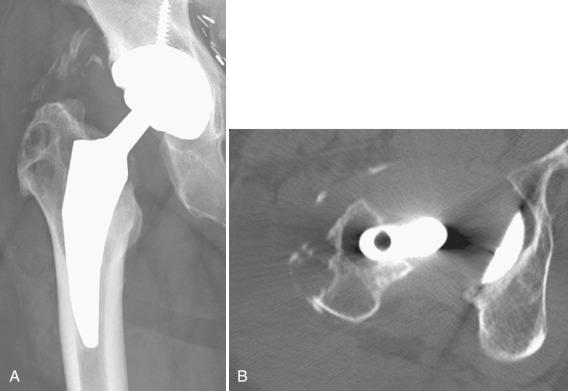
The distinction between delayed infection and failure related to prosthetic wear debris can be very difficult to detect. In many instances it requires correlation of the clinical findings, imaging studies, and laboratory tests, such as the sedimentation rate and the level of C-reactive protein. All too frequently these data are nonconclusive, and the next step is frozen section histologic examination of the tissue adjacent to the implant at the time of joint replacement. Studies have shown that the identification of five neutrophils in five consecutive separate high-power fields excluding surface exudates and neutrophils enmeshed within fibrin aggregates correlates with culture-proven infection ( Fig. 14.26 , Box 14.3 ). This technique has relatively low sensitivity (29%) but high specificity (95%). Practical suggestions for performing this technique include the following: (1) prepare a minimum of three cassettes per specimen and (2) identify the surface of the tissue that abutted the prosthesis (is shiny and frequently smooth) and section it in a perpendicular plane—if neutrophils are present they are most numerous in the superficial portion of the tissue.
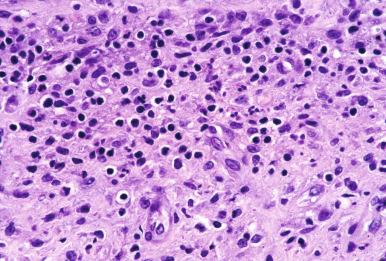
Placement
Five neutrophils in five consecutive high-power fields
Neutrophils enmeshed in fibrin
Exclude surface exudates
The treatment of an infected prosthesis frequently involves surgical and medical therapy. The surgical procedures range from reimplantation either at the time of resection (one-stage replacement) or in a second surgery (two-stage replacement), excision of diseased tissue with preservation of the prosthesis, complete resection with or without arthrodesis, to amputation. The type of pathogen, amount and condition of the residual bone and soft tissues, antimicrobial susceptibility of the infecting microorganism, and the patient's medical condition are factors that influence the surgical treatment strategy. The two-stage reconstruction is optimal, and after removal of the implant the structural integrity of the site can be temporarily maintained by an antibiotic-impregnated spacer or cement. The patient is also treated with parenteral antibiotics and after 4 to 6 weeks after the site is sterilized a new prosthesis is implanted. The cost for the treatment of this complication is more than $50,000.
Mycobacteria are aerobic and usually nonmotile bacteria that are acid-alcohol fast and have thick cell walls that are hydrophobic and rich in mycolic acids. Within the genus Mycobacterium , greater than 120 different species are currently recognized. The majority are not pathogenic and are ubiquitous in the environment, with their natural reservoirs being water, soil, aerosols, dust, animals, and foods. The major human pathogenic mycobacterium is Mycobacterium tuberculosis ; however, Mycobacterium leprae and Mycobacterium ulcerans are also responsible for significant human disease. The major differences between M. tuberculosis and the nontuberculous mycobacteria are the virulence of the organisms and the potential for human to human transmission. Nontuberculous mycobacteria are generally of low virulence and are not associated with human to human spread. The successful pathogens have the capability to reside and proliferate within host macrophages despite the bactericidal properties of these cells. The macrophages are a component of the complex immune response involving both innate and adaptive systems that sequesters the microorganisms within granulomas. Overall, mycobacterial infection of the skeletal system is much less frequent than bacterial osteomyelitis.
Tuberculosis is defined as an infectious disease caused by M. tuberculosis . It affects 1.8 billion people annually and is the leading cause of death associated with an infectious disease and is responsible for the death of approximately 3 million people annually.
Tuberculous osteomyelitis has plagued mankind for millennia. Evidence of bone disease has been found in Egyptian mummies and the skeletal remains dating from the Iron Age. A resurgence of tuberculous osteomyelitis has occurred in industrialized nations that have been attributed to the influx of immigrants from Third World countries and greater numbers of immunosuppressed people. In developing countries the affected individuals are usually adolescents or young adults, whereas in the indigenous population of the United States, the victims tend to be older, except for those who are immunosuppressed. In the United States the incidence of tuberculosis is currently on the decline but remains an important health problem. Approximately 1% to 3% of patients with pulmonary tuberculosis also have osseous disease, and 10% of all cases of extrapulmonary tuberculosis are caused by bone infection.
Mycobacteremia is the mechanism that underlies most cases of bone disease, with the organisms originating from foci of active visceral disease that are in the initial stages of primary infection. Direct extension (e.g., from a pulmonary focus into a rib or from tracheobronchial nodes into adjacent vertebrae) or spread via draining lymphatics or Batson venous plexus from the lung to the spine may also occur. The bone infection is usually solitary and in some cases may be the only clinical manifestation of the disease and may fester for years before being recognized. Patients with acquired immune deficiency syndrome (AIDS) frequently have multifocal bone involvement, which results from widespread hematogenous dissemination.
The spine is affected in 40% to 50% of cases of tuberculous osteomyelitis and is followed in frequency by the hips and knees in 25% and 20% of cases, respectively. Spinal infection occurs 2 to 10 times more frequently in HIV-infected patients. In the spine, 98% of infections are centered in the anterior column, and the involved level is usually located in the region of T6 through L3. Thoracic disease is more frequent in children, whereas in adults the lumbar area is more often involved.
Patients present with insidious symptoms that develop over a period of months to a year or longer. Common manifestations are low-grade fevers, weight loss, pain that is regional and ranges from mild to severe, swelling, local warmth without erythema, muscle spasms and atrophy, limitation of range of motion, limping, gibbus formation, and soft tissue masses. The latter is typically a manifestation of a cold abscess.
Radiographically, nuclear magnetic resonance is the modality of choice for assessing spinal tuberculosis because plain films and CT are not very sensitive and do not adequately demonstrate marrow involvement. The disease first begins in the anterior subchondral region of the vertebral body ( Fig. 14.27 ). It may initially appear as a localized area of osteoporosis with loss of the subchondral bone plate. On MRI the inflammatory bone marrow changes manifest as patchy high signal intensity on T2-weighted images and low signal intensity of T1-weighted images. Continued expansion of the infection produces disruption of the cortex and spread into the neighboring disc. In comparison with purulent bacterial discitis, the disc space in tuberculosis may show only limited narrowing on imaging studies despite the presence of extensive bone destruction—this is an important diagnostic feature of tuberculous spondylitis. Progressive disease causes erosion of the anterior and lateral cortices, leading to angular collapse with posterior projection and deformity (Pott disease). The angle of the projection is most severe when only one or two vertebral bodies have collapsed ( Fig. 14.28 ). If the bony collapse involves one side of the vertebral body greater than the other, then lateral angulation may also occur. Within the bone, bright signal intensity on T2-weighted images surrounding a central region of low signal intensity on T1-weighted images reflects the presence of an intraosseous abscess. The rim of the abscess shows intense enhancement after the administration of contrast agents, such as gadolinium. Craniocaudal spread beneath the anterior longitudinal ligament produces involvement of multiple vertebral bodies, and sometimes this is associated with the sparing of one or intervening vertebrae—skip lesions. Extensive disease may be associated with involvement of the posterior elements and epidural space and the development of large paravertebral abscesses ( Fig. 14.29A and B ). In exceptional cases the abscesses may dissect along tissue planes and produce large distant masses that can compress organs, erode bones, and present as soft tissue masses. Those growing along the psoas fascia can extend beneath the inguinal ligament and present as a thigh mass ( Fig. 14.30 ). The wall of abscess may calcify in longstanding disease and the abscess can continue to burrow and form fistulas and draining sinuses.
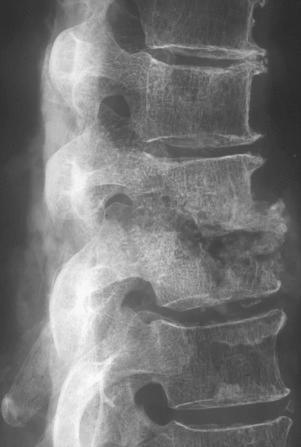
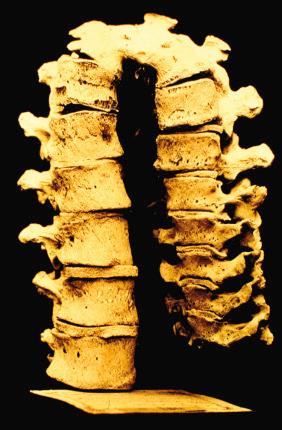
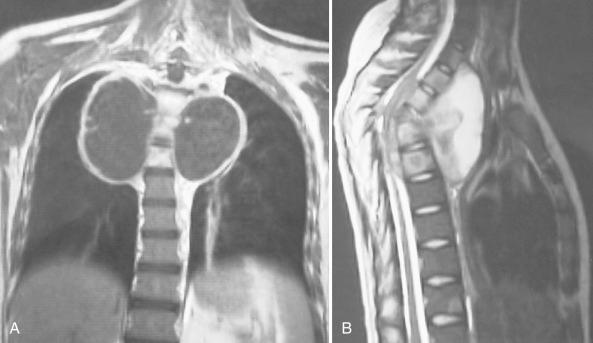
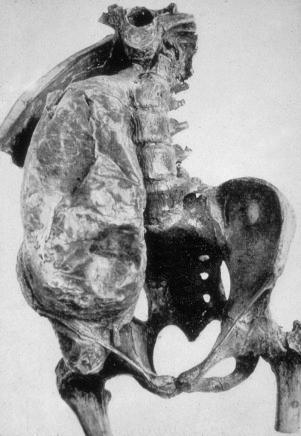
Tuberculous osteomyelitis of the appendicular skeleton usually begins in the metaphysis and extends into the epiphysis, with joint involvement being commonplace. As a result, subchondral bone destruction and periarticular erosions occur on both sides of the joint and are characteristic of the disease ( Fig. 14.31 ). Large regions of bone may be destroyed with poorly defined margins, sequestrate, and periosteal reaction. Accompanying spread into the soft tissue and abscess formation may also develop.
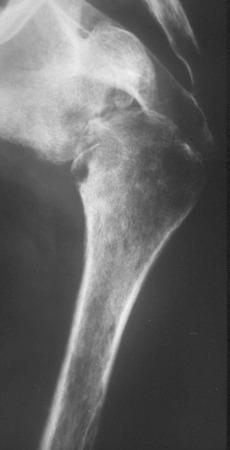
Grossly, infected bone is discolored pale tan—yellow-white-gray, and the involved area is poorly defined and may extend through the cortex into the soft tissues. In miliary disease the individual granulomas appear as pinpoint, round, white-gray nodules. In regions of bone destruction, firm fibroinflammatory tissue replaces the bone except in areas of abscess formation. Abscess cavities are filled with liquid of various viscosity and range in color from light green-yellow to brown and sometimes contain pieces of bone that may be finely granular (“bone sand”).
Histologically the sine qua non of tuberculous osteomyelitis is necrotizing granulomatous inflammation ( Fig. 14.32 ). The granulomas or tubercles are round to oval and composed of aggregates of polyhedral macrophages that have oval or kidney bean–shaped vesicular nuclei and abundant eosinophilic cytoplasm. Admixed are multinucleated giant cells, including Langhans-type giant cells. Scattered around the granulomas are small mature-appearing lymphocytes, all of which are enmeshed in fibrovascular connective tissue. Areas of necrosis vary in size from microscopic, occurring in the centers of the granulomas, to large grossly visible regions. The type of necrosis is caseous in nature being an admixture of coagulative and liquefactive devitalization. Histologically the necrotic tissue is amorphous and eosinophilic and contains scattered neutrophils, nuclear debris, and coagulated fibrin and is bordered by histiocytes. The surrounding tissue consists of granulation tissue with variable numbers of granulomas. The involved bone is necrotic and shows evidence of previous osteoclastic resorption. The neighboring uninvolved bone is sclerotic with reactive new bone formation, and loose granulation tissue fills the intertrabecular spaces.
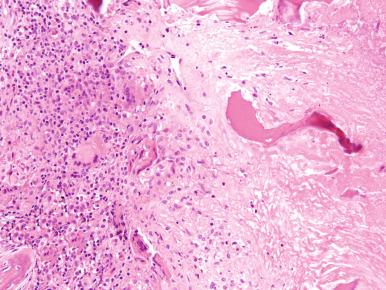
The microorganisms are usually most numerous in the areas of necrosis; however, they can also be found in the cytoplasm of macrophages. Tuberculosis are gram positive, and using acid-fast histochemical stains, such as the Ziehl-Neelsen stain, they appear as red rod-shaped structures that are 2 to 4 µm in length and 0.2 to 0.5 µm in diameter ( Fig. 14.33 ).
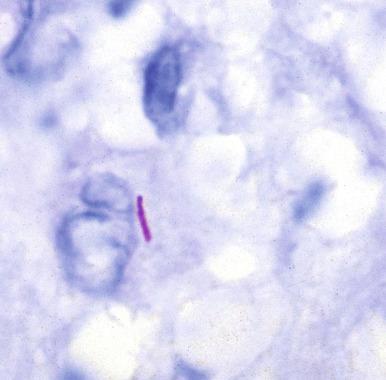
Spinal tuberculosis causes significant bone destruction, which can result in permanent severe scoliotic or kyphotic deformities with subluxations, contractures, and neurologic deficits, including paralysis secondary to spinal cord and nerve compression. Tuberculous osteomyelitis tends to be more destructive and resistant to control than pyogenic osteomyelitis. Treatment is usually a combination multidrug therapy and surgery and is not always successful.
Nontuberculous mycobacteria are relatively nonvirulent and are present throughout our environment. Nontuberculous mycobacterial infection in humans has been well established since the 1930s; however, the introduction of immunosuppressive therapy and the development of HIV infection have created the conditions for a significant increase in the frequency of this type of disease. There are more than 150 species, approximately 60 have been documented to cause human illness, and new species are being reported on a continual basis. Despite this, relatively few species are responsible for the majority of infections, with Mycobacterium avium-intracellulare causing 61% of cases, followed by Mycobacterium fortuitum (19%) and Mycobacterium kansasii (10%). Currently, nontuberculous mycobacterial infection accounts for 0.5% to 30% of all mycobacterial diseases, and this percentage is on the rise. A strong relationship exists between the type of infecting mycobacteria species and the geographic area of the population. The gamut of clinical infections caused by these organisms is broad, and they can be classified into chronic pulmonary infection, lymphadenitis, soft tissue and osteoarticular infection, disseminated disease, and iatrogenic illnesses. Abnormalities with interferon-γ and the interleukin-12 pathway are hypothesized in predisposing individuals to infection.
Approximately 5% to 10% of patients with nontuberculous mycobacterial disease have involvement of the musculoskeletal system. The predisposing factors of bone infection are trauma, surgery, and immunocompromise. The patients tend to be young and are infected by inoculation of the organism into the soft tissues, with secondary spread into the adjacent bone or directly into osseous structures as a result of penetrating trauma, contamination of open wounds, or introduction into the body via medical devices, such as catheters, shunts, injections, and surgical procedures. The organisms responsible for this type of infection are usually Mycobacterium abscessus , M. fortuitum , Mycobacterium chelonae , Mycobacterium haemophilum , Mycobacterium marinum , M. avium-intracellulare , M. kansasii , and Mycobacterium terrae . Patients who are immunosuppressed often have disseminated disease, and the mycobacteria spreads to the skeleton hematogenously, causing multiple lesions that tend to affect the metaphyseal and diaphyseal regions of the long bones. Patients with osteomyelitis caused by M. chelonae and M. haemophilum are usually immunosuppressed.
Several clinical associations are well known. (1) M. marinum produces a condition known as swimming pool granuloma or fish tank granuloma in people exposed to forms of a marine environment. Local trauma, especially in the extremities, provides a pathway of access for the organism into the tissues. (2) M. ulcerans produces chronic necrotizing skin lesions of the distal extremities known as Buruli ulcer. It is associated with secondary bone involvement in approximately 15% of cases and is most prevalent in West Africa and Australia.
Patients with nontuberculous mycobacterial osteomyelitis frequently present with localized pain, swelling, erythema, and induration of the involved site. They may also exhibit low-grade fever, sweats, chills, anorexia, malaise, and weight loss. In Buruli ulcer the lesion is nonpainful and associated with deep ulcers, which undermine the skin edges.
The radiographic findings of nontuberculous mycobacteria are similar to those caused by acute pyogenic bacterial osteomyelitis, but the rate of progression is slower; in the spine the changes resemble tuberculous spondylitis. The infection results in bone resorption, sequestrum formation, deposition of reactive new bone (involucrum), and the development of sinus tracts. In some cases, the plain films may show a honeycomb pattern of bone dissolution or sometimes lytic cystic-appearing areas of bone destruction with limited surrounding sclerosis. In immunosuppressed patients the lesions are usually multifocal and lytic.
The histologic reaction to the mycobacteria is variable and depends to some degree on the immune status of the host. The infection may elicit caseating and nonnecrotizing granulomas, nonspecific chronic inflammation with lymphocytes, plasma cells and macrophages, and areas of tissue necrosis with little inflammation ( Fig. 14.34 ). Immunosuppressed patients frequently have no granulomatous inflammation, and innumerable organisms may be present in histiocytes. The mycobacteria stain with Ziehl-Neelsen and Fite special stains.
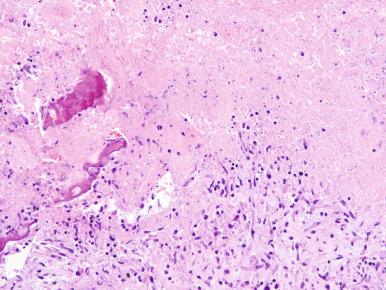
The treatment of nontuberculous mycobacterial osteomyelitis is usually a combination of surgery and multidrug antimycobacterial chemotherapy. Excision of infected should be performed if feasible, and contaminated prostheses or hardware should be removed.
The bone changes associated with leprosy may result from direct infection of the organism or the complications of the disease, including deep ulceration and superimposed infection and neuropathic changes. It is estimated that 3% to 5% of hospitalized leprosy patients have bone involvement. The bones most commonly affected are the small bones of the face, especially the nose, hands, and feet. The slowly progressive and relentless infection spreads from the skin, mucosa, and soft tissues into the underlying bone, producing lytic lesions and gradual resorption of the involved bone. Those bones that tend to show the greatest destruction ( Figs. 14.35 to 14.38 ). The pathology reveals bone necrosis and resorption, marrow fibrosis, and histiocytes, sometimes forming granulomas and occasional Langhans giant cells ( Fig. 14.39 ). Bone involvement is usually indicative of chronic disease and is treated with antibiotics and surgery.
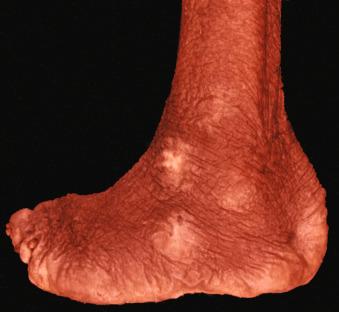
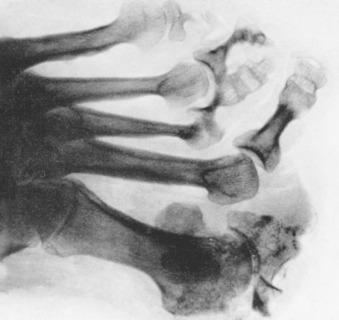
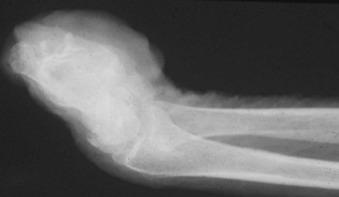
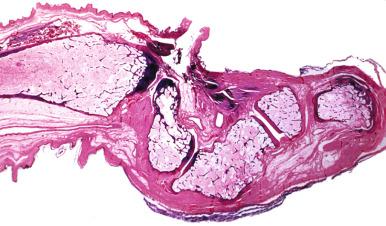
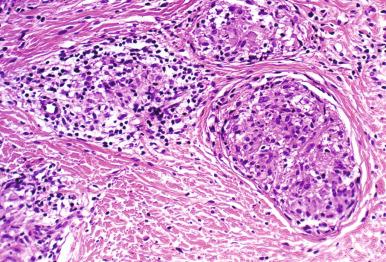
Become a Clinical Tree membership for Full access and enjoy Unlimited articles
If you are a member. Log in here